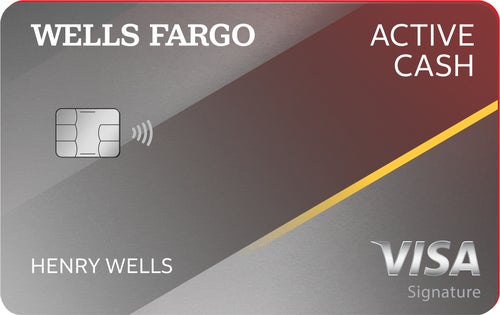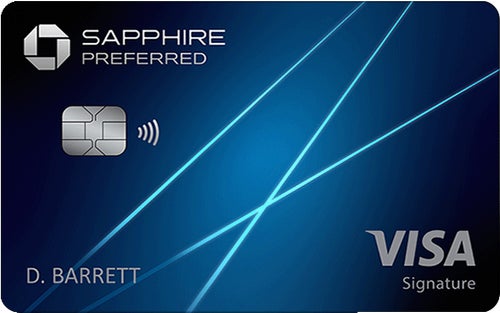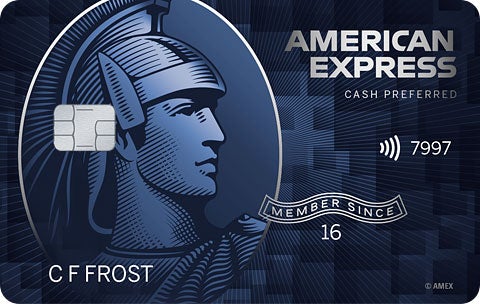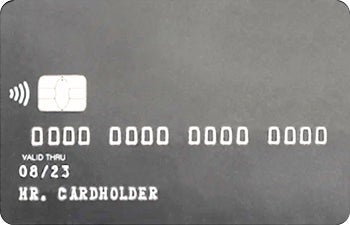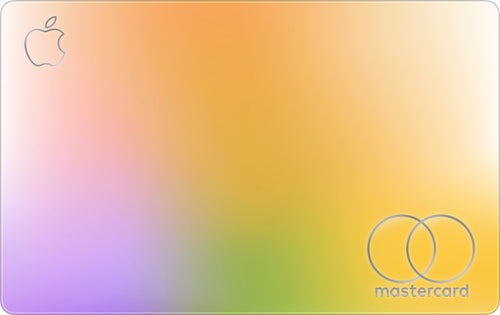Some credit cards are better for couples than others, depending on the couple’s financial goals. For example, there are credit cards that allow joint accounts to help you build your credit as a couple. If only one of you has stellar credit, choosing a card that allows an authorized user can help the other partner rebuild credit while still earning rewards. There are other cards that make it easy for couples to double up on credit card welcome bonuses and rewards for spending, and some even let couples pool their points together in the same account.
Each of the cards on our list was chosen for a different goal, whether it’s earning rewards, building credit and establishing a true joint credit card account.
The Wells Fargo Active Cash® Card gives couples the chance to earn 2% cash rewards for their purchases with no annual fee. Plus, each person who applies and is approved for the card can earn a $200 cash rewards bonus after spending $500 in purchases within three months of account opening.
The Wells Fargo Active Cash® Card may not have any bonus reward categories, but it doesn’t have any reward caps either. This means a couple can maximize their cash rewards on spending by using their cards for everything they buy.
- Intro Balance Transfer APR
- 0% intro APR for 15 months from account opening on qualifying balance transfers
- Intro Purchase APR
- 0% intro APR for 15 months from account opening
- Regular APR
- 20.24%, 25.24%, or 29.99% Variable APR
- Balance Transfer Fee
- up to 5%, min: $5
The Wells Fargo Active Cash® Card gives couples the chance to earn 2% cash rewards for their purchases with no annual fee. Plus, each person who applies and is approved for the card can earn a $200 cash rewards bonus after spending $500 in purchases within three months of account opening.
The Wells Fargo Active Cash® Card may not have any bonus reward categories, but it doesn’t have any reward caps either. This means a couple can maximize their cash rewards on spending by using their cards for everything they buy.
- Intro Balance Transfer APR
- 0% intro APR for 15 months from account opening on qualifying balance transfers
- Intro Purchase APR
- 0% intro APR for 15 months from account opening
- Regular APR
- 20.24%, 25.24%, or 29.99% Variable APR
- Balance Transfer Fee
- up to 5%, min: $5
The Chase Sapphire Preferred® Card earns points in the Chase Ultimate Rewards program, which are redeemable for cash back, statement credits, gift cards, travel through Chase Travel℠ or 1:1 point transfers to Chase airline and hotel partners. It comes with a $95 annual fee, but cardholders can earn 60,000 bonus points worth $750 in travel through Chase Travel after spending $4,000 on purchases within three months of account opening.
It earns the most rewards for travel purchased through Chase and for Lyft rides (through March 2025), but it also offers a solid rate for all your food needs, whether you’re dining out or cooking from your Airbnb. Its last reward category covers all forms of travel. The Chase Ultimate Rewards program lets couples who live at the same address pool their rewards in one account for convenience or better redemptions.
Cardholders also get a 25% redemption bonus when they redeem for travel through Chase. Other perks include primary auto rental collision damage waiver, Doordash and Instacart benefits, and bonus points on your account anniversary equal to 10% of your total purchases made the previous year (for example, if you spend $25,000 on purchases, you’ll get 2,500 bonus points).
- Intro Balance Transfer APR
- N/A
- Intro Purchase APR
- N/A
- Regular APR
- 21.49% – 28.49% Variable
- Balance Transfer Fee
- Either $5 or 5% of the amount of each transfer, whichever is greater.
The Chase Sapphire Preferred® Card earns points in the Chase Ultimate Rewards program, which are redeemable for cash back, statement credits, gift cards, travel through Chase Travel℠ or 1:1 point transfers to Chase airline and hotel partners. It comes with a $95 annual fee, but cardholders can earn 60,000 bonus points worth $750 in travel through Chase Travel after spending $4,000 on purchases within three months of account opening.
It earns the most rewards for travel purchased through Chase and for Lyft rides (through March 2025), but it also offers a solid rate for all your food needs, whether you’re dining out or cooking from your Airbnb. Its last reward category covers all forms of travel. The Chase Ultimate Rewards program lets couples who live at the same address pool their rewards in one account for convenience or better redemptions.
Cardholders also get a 25% redemption bonus when they redeem for travel through Chase. Other perks include primary auto rental collision damage waiver, Doordash and Instacart benefits, and bonus points on your account anniversary equal to 10% of your total purchases made the previous year (for example, if you spend $25,000 on purchases, you’ll get 2,500 bonus points).
- Intro Balance Transfer APR
- N/A
- Intro Purchase APR
- N/A
- Regular APR
- 21.49% – 28.49% Variable
- Balance Transfer Fee
- Either $5 or 5% of the amount of each transfer, whichever is greater.
The Blue Cash Preferred® Card from American Express* lets cardholders earn 6% cash back on up to $6,000 spent at U.S. supermarkets each year (then 1% back), 6% back on select U.S. streaming subscriptions, 3% cash back at U.S. gas stations, 3% cash back on transit and 1% back on other purchases. New cardmembers can also earn a $250 statement credit after spending $3,000 in purchases within the first six months of account opening.
A $95 annual fee applies, but there is a $0 intro annual fee for the first year. And with the rewards you’ll be pulling in, it’s easy to forget about.
This card has a spending cap on its U.S. supermarket category, but couples with their own accounts can each spend and earn bonus rewards up to the limit. Partners who apply for the card separately can also earn separate welcome offers with this card.
- Intro Balance Transfer APR
- 0% on balance transfers for 12 months
- Intro Purchase APR
- 0% on purchases for 12 months
- Regular APR
- 19.24% – 29.99% Variable
- Balance Transfer Fee
- Either $5 or 3% of the amount of each transfer, whichever is greater.
The Blue Cash Preferred® Card from American Express* lets cardholders earn 6% cash back on up to $6,000 spent at U.S. supermarkets each year (then 1% back), 6% back on select U.S. streaming subscriptions, 3% cash back at U.S. gas stations, 3% cash back on transit and 1% back on other purchases. New cardmembers can also earn a $250 statement credit after spending $3,000 in purchases within the first six months of account opening.
A $95 annual fee applies, but there is a $0 intro annual fee for the first year. And with the rewards you’ll be pulling in, it’s easy to forget about.
This card has a spending cap on its U.S. supermarket category, but couples with their own accounts can each spend and earn bonus rewards up to the limit. Partners who apply for the card separately can also earn separate welcome offers with this card.
- Intro Balance Transfer APR
- 0% on balance transfers for 12 months
- Intro Purchase APR
- 0% on purchases for 12 months
- Regular APR
- 19.24% – 29.99% Variable
- Balance Transfer Fee
- Either $5 or 3% of the amount of each transfer, whichever is greater.
The Discover it® Secured Credit Card* requires a refundable cash deposit of at least $200 that’ll form your starting credit limit. Discover reports payments and balances to the credit bureaus to help customers build credit over time with responsible use.
This card also comes with no annual fee, and cardholders earn 2% cash back on up to $1,000 spent at restaurants and gas stations each quarter (then 1% back) and 1% cash back on other purchases. At the end of your first year with the card, Discover will also essentially double all rewards earned during the first year.
Couples who need to build credit independently can each get started with their own secured credit card. The Discover it® Secured Credit Card is one of the best options out there since it earns rewards and helps build credit with no annual fee.
- Intro Balance Transfer APR
- 10.99% for 6 months
- Intro Purchase APR
- N/A
- Regular APR
- 28.24% Variable APR
- Balance Transfer Fee
- 3% intro balance transfer fee, up to 5% fee on future balance transfers (see terms)*
The Discover it® Secured Credit Card* requires a refundable cash deposit of at least $200 that’ll form your starting credit limit. Discover reports payments and balances to the credit bureaus to help customers build credit over time with responsible use.
This card also comes with no annual fee, and cardholders earn 2% cash back on up to $1,000 spent at restaurants and gas stations each quarter (then 1% back) and 1% cash back on other purchases. At the end of your first year with the card, Discover will also essentially double all rewards earned during the first year.
Couples who need to build credit independently can each get started with their own secured credit card. The Discover it® Secured Credit Card is one of the best options out there since it earns rewards and helps build credit with no annual fee.
- Intro Balance Transfer APR
- 10.99% for 6 months
- Intro Purchase APR
- N/A
- Regular APR
- 28.24% Variable APR
- Balance Transfer Fee
- 3% intro balance transfer fee, up to 5% fee on future balance transfers (see terms)*
The Apple Card* offers the potential to earn 3% cash back at select merchants when you pay with Apple Pay, 2% on other purchases made with your card with Apple Pay and 1% cash back on other purchases. This card has no annual fee, late fee, foreign transaction fee or hidden fees.
That said, cardholders need to have an Apple phone or device to access this card and its benefits.
The Apple Card is one of the few credit cards on the market that allows true joint accounts. This option lets two people share a single line of credit together, and it’s available through the Apple Card Family program.
- Intro Balance Transfer APR
- N/A
- Intro Purchase APR
- N/A
- Regular APR
- 19.24% to 29.49% Variable
- Balance Transfer Fee
- N/A
The Apple Card* offers the potential to earn 3% cash back at select merchants when you pay with Apple Pay, 2% on other purchases made with your card with Apple Pay and 1% cash back on other purchases. This card has no annual fee, late fee, foreign transaction fee or hidden fees.
That said, cardholders need to have an Apple phone or device to access this card and its benefits.
The Apple Card is one of the few credit cards on the market that allows true joint accounts. This option lets two people share a single line of credit together, and it’s available through the Apple Card Family program.
- Intro Balance Transfer APR
- N/A
- Intro Purchase APR
- N/A
- Regular APR
- 19.24% to 29.49% Variable
- Balance Transfer Fee
- N/A
What is a credit card for couples?
Credit cards for couples can come in different forms, including options like joint accounts or two partners each opening the same credit card with the goal of doubling up on benefits and rewards. In some cases, couples can also list each other as an authorized user on their credit card account, which lets their partner use the same line of credit and earn rewards together.
Open a joint credit card account
Very few credit cards actually allow joint accounts -- with the exception of the Apple Card. Consider the pros and cons of joint accounts before you open one with your partner.
Pros
Couples can build credit and earn rewards together.
Partners can easily see each other’s spending in real time.
Both parties are legally responsible for repaying the debt.
Pay just one monthly credit card bill instead of two.
Cons
Complications can occur if the relationship unravels.
Since one person isn’t solely responsible for repaying the debt, miscommunication can lead to missed payments.
Seeing each other’s spending can lead to problems and disagreements.
Joint cards have one line of credit and credit limit, which could be lower than the limit for two separate cards.
Add each other as authorized users
When a couple doesn’t want a joint account or entirely separate credit card accounts, they can consider adding one person to the other person’s account as an authorized user.
Pros
Track spending and pool rewards in one account.
Authorized users earn rewards on purchases just like primary accounts.
Partners with imperfect credit get access to a credit card and earn rewards when they may not be able to qualify on their own.
Cons
Authorized user accounts typically don’t count toward building credit as much as primary credit accounts.
The primary account holder is solely responsible for repayment.
Authorized user accounts don’t earn a separate welcome bonus when the other person is added to the account.
Some credit cards charge an annual fee for authorized users.
Open separate accounts of the same card
There are numerous scenarios where it makes the most sense for couples to apply for their own credit card accounts. However, there are downsides to be aware of.
Pros
Couples with separate cards can both earn their own credit card welcome bonus.
Some credit cards let couples pool their rewards in one account.
Separate cards afford more freedom and a greater sense of ownership over their credit.
Both partners build credit with a credit card over time.
Cons
Couples may wind up paying multiple annual fees when they have several cards.
Some credit cards for couples have overlapping benefits.
Having separate accounts makes it easier to keep financial secrets.
Best credit card strategies for couples
Couples who apply for a credit card with a joint account, as an authorized user on each other’s accounts or with separate accounts should be as strategic as they can.
Earn more rewards
Each person having a rewards credit card ensures a greater haul at the end of each year. This is true whether couples opt for a cash back credit card or one that earns travel rewards they can use for their next getaway.
Earn a welcome bonus (twice)
Having both partners sign up for a separate credit card account makes it possible to earn two welcome bonuses as long as each account meets the minimum spending requirement. These bonuses help couples maximize their yearly rewards.
And yes, credit card issuers will let couples who live at the same address get approved for the same credit card and allow each to earn a welcome bonus.
Pair two different cards
Couples can also get two different credit cards with the goal of maximizing rewards. For example, one person can get a credit card with no annual fee to boost cash back rewards for spending, and the other can get a card that offers points that work well for travel.
This works best for credit card rewards programs that let couples pool their points in one account. For example, one person could get the Chase Freedom Unlimited® with no annual fee and the other person could get the Chase Sapphire Preferred® Card. They could then pool all points in the Preferred account to get 25% more value when redeeming for travel through Chase or find an even better value by transferring points to Chase’s airline and hotel partners.
Additional credit card options for couples
- Chase Freedom Flex℠: This no annual fee credit card lets cardholders earn 5% cash back on up to $1,500 spent in rotating quarterly bonus categories (activation required; then 1% back), plus 5% back on Lyft rides (through March 2025), 3% back on dining and drugstore purchases and 1% back on other spending.
- Citi Premier® Card: This flexible travel credit card lets cardholders share points with other members of the Citi ThankYou program, although shared points must be used within 90 days or they expire. It charges a $95 annual fee, yet couples can each earn a generous welcome bonus and earn rewards in popular spending categories.
- American Express® Gold Card*: This rewards card for foodies earns 4X points at restaurants worldwide (including takeout and delivery in the U.S.), 4X points on up to $25,000 spent at U.S. supermarkets each year (then 1X points), 3X points on airfare booked directly with airlines or through Amextravel.com and 1X points on other purchases. However, with a $250 annual fee, it’s more expensive than other options.
How to apply for a credit card for couples
Picking the right credit card for couples is only half the battle. The other half is applying:
- Compare credit cards: Compare the best credit cards for couples to find options that offer benefits and rewards that make sense for your joint goals. This could be a cash-back credit card, a travel credit card or even two different credit cards that complement each other.
- Check your credit scores: Both partners should use a program like Capital One CreditWise or Chase Credit Journey to get a free look at their credit scores. This can help decide if one partner should be an authorized user or if both partners can get their own accounts.
- Apply securely on the credit card issuer’s website: Once you find a credit card that suits your needs, you can apply online. Filling out the application will require you to share details like your full name, address, phone number, monthly mortgage or rent payment, household income and Social Security number (SSN).
- Find out if you’re approved: Many credit card issuers will let you know if you’re approved for a card within minutes of submitting your application online. Otherwise, you’ll find out about an approval or denial via email or regular postal mail.
FAQs
The best credit card for couples is the Wells Fargo Active Cash. It offers a competitive rewards rate, an introductory purchase APR and a number of useful perks.
Unmarried couples have all the same options as married couples when it comes to getting credit cards. They can each apply for their own account, add each other as an authorized user or apply for a joint credit card like the Apple Card.
Married couples may want to have their own credit card accounts so they are each building their own credit history through responsible use. Separate credit cards for married couples can also offer additional benefits like earning two welcome bonuses or pooling rewards.
For rates and fees of the Blue Cash Preferred Card from American Express, click here.
*All information about the Discover it Secured Credit Card, Blue Cash Preferred Card from American Express, American Express Gold Card, Apple Card and Chase Freedom Flex has been collected independently by CNET and has not been reviewed by the issuer.
Recommended Articles
The editorial content on this page is based solely on objective, independent assessments by our writers and is not influenced by advertising or partnerships. It has not been provided or commissioned by any third party. However, we may receive compensation when you click on links to products or services offered by our partners.


